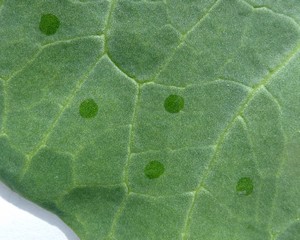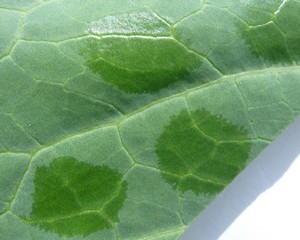PESTS AND DISEASES OF FORESTRY IN NEW ZEALAND
Phosphite shows promise for red needle cast control
Scion is the leading provider of forest-related knowledge in New Zealand
Formerly known as the Forest Research Institute, Scion has been a leader in research relating to forest health for over 50 years. The Rotorua-based Crown Research Institute continues to provide science that will protect all forests from damage caused by insect pests, pathogens and weeds. The information presented below arises from these research activities.
From Forest Health News 260, September 2015.
In June 2015, we gave an update on research to control dothistroma needle blight and red needle cast using copper fungicide (FH News 257: Controlling needle diseases of pines).
Work on another type of fungicide to control red needle cast has also made good progress. Phosphite has been shown to control Phytophthora diseases associated with woody plants, e.g. sudden oak death in North America and root rot in New Zealand forest nurseries.
Typical droplet spreading on cabbage leaves of solutions applied one hour after mixing. (Photos courtesy of Plant Protection Chemistry NZ)


Phosphite fungicides are systemic and act in two ways - directly on the pathogen and also indirectly by stimulating host defence responses to suppress disease development.
The effect can persist for over a year after application, however, persistence is host dependent. In order to work most effectively, phosphite needs to be taken up efficiently by the host. If phosphite uptake can be maximised then the applied dose can be accordingly reduced, hopefully leading to less chemical applied with efficacy maintained. Uptake of phosphite can be improved by using adjuvants which have the potential to improve spray deposition, penetration, droplet spread and retention.
Initial tests found that phosphite applied as the fungicide Agri-Fos®600 with the adjuvant Du-Wett® gave good uptake of the active ingredient. However, subsequent experiments indicated that the adjuvant was being rapidly degraded by Agri-Fos®600, basically rendering the effect of the adjuvant null, resulting in poor uptake. This was particularly so at rates of phosphite tested above an application dose of 6 kg/ha, when not applied immediately after mixing. The effect was demonstrated by NMR spectroscopy and droplet spread tests. This was a surprising result given the early successes demonstrated by the Agri-Fos®600 and Du-Wett® product/adjuvant combination.
Experiments carried out by Plant Protection Chemistry NZ found that another phosphite product, Foschek™, did not break down Du-Wett®, and other adjuvants, at any concentration tested. More importantly, the uptake of Foschek™, applied at the equivalent of 12 kg/ha phosphite, was over five times better than that of Agri-Fos®600, with no difference in uptake between Foschek™ applied alone and in combination with an adjuvant.
That result is supported by spread tests on cabbage leaves (an accepted medium for droplet spread tests*) shown above. Note the limited droplet spread on the top photo compared with the bottom.
This work has markedly advanced progress towards deployment of an operational chemical control system for red needle cast. Foschek™ did not interfere with the adjuvant and, more importantly, an adjuvant may not be required to enhance uptake of phosphite when applied as this product. This outcome should have positive effects on the cost/benefit of spraying phosphite for control of red needle cast.
Carol Rolando and Stefan Gous
This information is intended for general interest only. It is not intended to be a substitute for specific specialist advice on any matter and should not be relied on for that purpose. Scion will not be liable for any direct, indirect, incidental, special, consequential or exemplary damages, loss of profits, or any other intangible losses that result from using the information provided on this site.
(Scion is the trading name of the New Zealand Forest Research Institute Limited.)

 Farm Forestry New Zealand
Farm Forestry New Zealand

